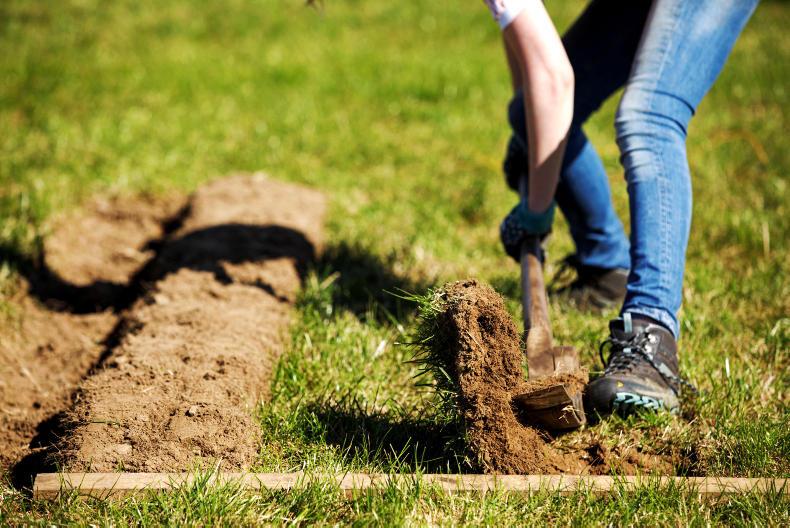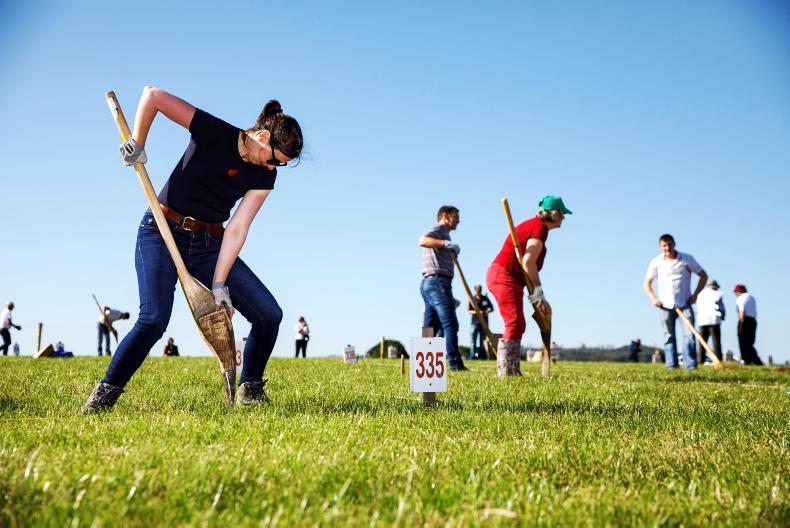Loy digging celebrates a very ancient tradition. Like all ploughing, it is literally a case of turning the sod. But there is no use of horse or tractor to pull the plough, the person ploughing is the sole source of power. This method is more than 4,000 years old, with spade ridges beneath the blanket bogs in north Mayo’s Céide fields dating back to the bronze age.

Lady loy diggers that took part in the All-Ireland Loy digging finals. \ Donal O'Leary
The tradition is kept alive by the loy association of Ireland and National Ploughing Association (NPA), with All-Ireland competitions held in five categories at the National Ploughing Championships every September.
Irish Country Living visited the ladies final on the Thursday of the Ploughing. It is real hard graft, better than any gym workout. The sun was beating down this year in Fenagh, Co Carlow, for the championships, making the ground hard and the work sweaty. Some seven competitors representing Galway, Westmeath, Mayo and Sligo fought hard for the first prize north Connaught Farmer’s Cup and €100. Those in second and third place got €60 each.
When the starting signal is sounded nicking commences. Three lines must be nicked and the lines lifted before digging commences.
On a base of 3’10”, a ridge will consist of two sods, turned towards each other leaving a verge in the centre. Each sod should be 10.5 inches wide with a centre verge four inches wide. The depth of the furrow is between three and four inches. For the ladies competition, there are three hours to dig 10ft ridges, the men do 30ft.
Family
Violet Hunter was representing Sligo in the 2019 ladies competition, while her husband George and two sons Alan and Glenn battled it out for the senior and junior loy digging titles.

Glenn, Violet, George and Alan Hunter, Carrickhenry, Ballisodare, Co Sligo, taking part in the All-Ireland loy digging finals at the National Ploughing Championship. \ Donal O'Leary
Violet has been loy digging for over 30 years, she says.
“George started off, my husband, and we’d go to all the counties; Longford, Leitrim, Donegal. [I used to be] sitting in the car waiting on him for two or three hours, so one day I decided I’d just give it a try. We’ve all learned from one another really,” Violet told Irish Country Living.
Watching the ladies compete, there is a lovely vibe. Everyone helps each other out, measuring lines and checking for straightness. However, with such a strong contingent from the west, the hard ground was a change from qualifying rounds during the spring.

“This is very hard. The land is way too dry, I thought they’d call it off. In the west of Ireland you have a lot more rain.
“We’ve had very wet seasons, in August it never stopped raining. And it’s so different here, it’s a different country. I’m all blistered and I’d have tough hands because we are dairy farming in Sligo.”
However, having such a strong family tradition of loy digging makes the trip to Carlow special for the Hunters. Alan is dairying at home and competed in the senior category with his father George. While Glenn is oyster fishing. The third brother Derek is also into it.
“We all had to qualify in our counties. It’s so special to have the four of us here, it’s just lovely to have it. The boys saw us doing it growing up and they get money competing. The boys at county level get up to €100.”
Kathleen Donaghey, Co Donegal.Marion Boyce,
Co Donegal.Niamh O’Grady,
Co Mayo.
Loy digging celebrates a very ancient tradition. Like all ploughing, it is literally a case of turning the sod. But there is no use of horse or tractor to pull the plough, the person ploughing is the sole source of power. This method is more than 4,000 years old, with spade ridges beneath the blanket bogs in north Mayo’s Céide fields dating back to the bronze age.

Lady loy diggers that took part in the All-Ireland Loy digging finals. \ Donal O'Leary
The tradition is kept alive by the loy association of Ireland and National Ploughing Association (NPA), with All-Ireland competitions held in five categories at the National Ploughing Championships every September.
Irish Country Living visited the ladies final on the Thursday of the Ploughing. It is real hard graft, better than any gym workout. The sun was beating down this year in Fenagh, Co Carlow, for the championships, making the ground hard and the work sweaty. Some seven competitors representing Galway, Westmeath, Mayo and Sligo fought hard for the first prize north Connaught Farmer’s Cup and €100. Those in second and third place got €60 each.
When the starting signal is sounded nicking commences. Three lines must be nicked and the lines lifted before digging commences.
On a base of 3’10”, a ridge will consist of two sods, turned towards each other leaving a verge in the centre. Each sod should be 10.5 inches wide with a centre verge four inches wide. The depth of the furrow is between three and four inches. For the ladies competition, there are three hours to dig 10ft ridges, the men do 30ft.
Family
Violet Hunter was representing Sligo in the 2019 ladies competition, while her husband George and two sons Alan and Glenn battled it out for the senior and junior loy digging titles.

Glenn, Violet, George and Alan Hunter, Carrickhenry, Ballisodare, Co Sligo, taking part in the All-Ireland loy digging finals at the National Ploughing Championship. \ Donal O'Leary
Violet has been loy digging for over 30 years, she says.
“George started off, my husband, and we’d go to all the counties; Longford, Leitrim, Donegal. [I used to be] sitting in the car waiting on him for two or three hours, so one day I decided I’d just give it a try. We’ve all learned from one another really,” Violet told Irish Country Living.
Watching the ladies compete, there is a lovely vibe. Everyone helps each other out, measuring lines and checking for straightness. However, with such a strong contingent from the west, the hard ground was a change from qualifying rounds during the spring.

“This is very hard. The land is way too dry, I thought they’d call it off. In the west of Ireland you have a lot more rain.
“We’ve had very wet seasons, in August it never stopped raining. And it’s so different here, it’s a different country. I’m all blistered and I’d have tough hands because we are dairy farming in Sligo.”
However, having such a strong family tradition of loy digging makes the trip to Carlow special for the Hunters. Alan is dairying at home and competed in the senior category with his father George. While Glenn is oyster fishing. The third brother Derek is also into it.
“We all had to qualify in our counties. It’s so special to have the four of us here, it’s just lovely to have it. The boys saw us doing it growing up and they get money competing. The boys at county level get up to €100.”
Kathleen Donaghey, Co Donegal.Marion Boyce,
Co Donegal.Niamh O’Grady,
Co Mayo. 








 This is a subscriber-only article
This is a subscriber-only article









SHARING OPTIONS: